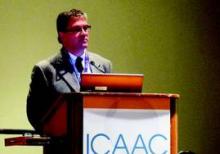WASHINGTON – While the U.S. waits for its first potential case of Ebola from a traveler, earlier this spring, officials at one hospital in Canada thought that they had a case and found themselves woefully unprepared.
In late March, a man who had returned from Liberia and had a fever of unknown origin, was admitted through the emergency department to the intensive care unit at St. Paul’s Hospital in Saskatoon, Sask. The clinicians suspected Ebola, but weren’t sure and late that night called the Saskatoon regional health department for a consultation.
Dr. Joseph Blondeau, interim head of pathology and laboratory medicine for the Saskatoon Health Region and the Royal University Hospital, took the call and set a process in motion that had been established for just such a moment, but later proved to have a variety of shortcomings, said Dr. Blondeau during a presentation at the Interscience Conference on Antimicrobial Agents and Chemotherapy.
Initially, the ICU clinicians treated the man empirically with a third-generation cephalosporin and vancomycin. There were still not enough details to make a definitive diagnosis, but by early the next morning there was a high level of suspicion. The patient was hemorrhaging from his eye, there was blood in his nasogastric tube, some rectal bleeding, and a diffuse and nonspecific rash.
Dr. Blondeau ordered all specimens from the man to be quarantined, and he activated the emergency response system for Canada. At that time, there were 27 cases in Liberia, with a 40% mortality rate.
Alarmingly, one of the patient’s cerebrospinal fluid specimens had leaked in transit from St. Paul’s Hospital to a biocontainment lab at the Royal University hospital. A technician at the lab attempted to clean the container and was potentially exposed.
Both St. Paul and Royal University hospitals decided they needed a communication strategy to help allay fear and anxiety among the staff. Many were questioning why the patient was not elevated to a high infection threat when admitted to the ICU, and why higher-level precautions had not been put into place earlier.
On his way to an emergency meeting at St. Paul’s to discuss these issues, Dr. Blondeau received a call from the director of one of Canada’s biosafety level 4 labs, the National Microbiology Lab in Winnipeg, Man., who said that it was likely the patient had Ebola.
“At that point in time all hell broke loose,” said Dr. Blondeau.
The patient’s specimens needed to be immediately transported for confirmation to that national lab, a 9-hour drive from Saskatoon. The regular couriers weren’t interested. Dr. Blondeau volunteered, initially thinking he would drive them.
The specimens were prepared and packaged for containment, but the government made the decision to transport them by jet instead.
Even so, Dr. Blondeau had to drive the specimens to the air ambulance that was waiting at the Saskatoon airport. He wondered whether that was the right decision. There were questions as to whether law enforcement should be informed of the transport – what if he had an accident? He put a sign in the windshield stating that he was transporting a potential Ebola specimen as a means of making it look official, and so that no one would mistake him for a terrorist. No one had worked out whether he should accompany the specimens to Winnipeg to maintain a chain of control. He did not go.
Simultaneously, the health authorities began trying to track down all of the patient’s contacts, from arrival in the country, through an urgent clinic visit, a busy emergency room, and staff and family visits after ICU admission.
Meanwhile, the patient was deteriorating and was already ventilated and required cardiovascular support. Dr. Blondeau began discussions to bring a more sophisticated mobile lab to Saskatoon so that the patient could be repeatedly tested on-site.
“I can say with certainty that there were not many people in the province of Saskatchewan who fully understood what was about to happen should this patient have tested positive for Ebola,” said Dr. Blondeau. “We were learning as we went.”
The plans were changing by the moment, he said.
And, he said, he still had many concerns about how the situation would be perceived by those inside and outside the hospital. There was a potential for public panic and for a breach of the patient’s and family’s privacy.
Among the staff, “there was tremendous fear and panic,” Dr. Blondeau said. The spouse of the lab technician who had a potential exposure wanted her to quit her job. Another technician was spreading incorrect information, he said.

